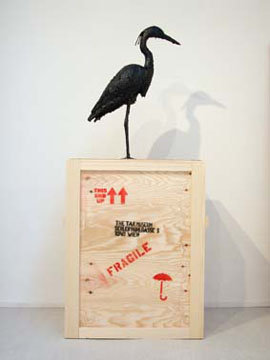Struggle for life
dal 20/11/2008 al 30/1/2009
Segnalato da
Dorothy Cross
Mark Dion
Carsten Holler
Jan Fabre
Klaus Fritze
Sanna Kannisto
Oliver van den Berg
Jess von der Ahe
20/11/2008
Struggle for life
Eres-Stiftung, Munich
Evolution and extinction in the anthropocentre. Exhibition and symposium. The event deals with the process of acclimatization and obliteration from both a scientific and artistic point of view. 8 artists have been chosen to address such aspects as our evolutionary legacy, the winners of the present development as well as the species that have already been wiped out. The scientific lectures takes place in the exhibition as an alternative to the stereotype images we are accustomed to in natural history museums, the media and advertizing. Works by: Dorothy Cross, Mark Dion, Carsten Holler, Jan Fabre, Klaus Fritze, Sanna Kannisto, Oliver van den Berg, Jess von der Ahe.

Two hundred years after Darwin’s birth and 150 years after the publication of his famous ON THE ORIGIN OF SPECIES expeditions still have plenty to discover. Explorers continue to find new species, as in the depths of the sea or in the Amazon basin. How many species exist on earth is impossible to say. But the planet’s biodiversity is gravely endangered. Every hour, three animal or plant species become extinct around the world. 16.306 are presently on the international »Red List« of the IUCN, the International Union for the Conservation of Nature. According to the UN’s climate report in spring of 2007, should global warming continue, close to every third animal and plant species will have disappeared by the end of this century.
Poignant images of polar bears or mountain gorillas whose habitats continue to shrink move us and stir our protective instincts but, as important as such emotional appeals are, we tend to lose sight of the big picture. We are now in the midst of the sixth largest period of animal and plant extinction in the earth’s history. This is due to factors caused by humans in the past 150 years, above all global warming and the intense use of land caused by the population explosion. Both developments can be compared with natural catastrophes that have disastrous effects on flora and fauna. If only a few key species in ecosystems disappear, that can lead to extinction on massive global level. It has already happened several times in the history of evolution.
The STRUGGLE FOR LIFE symposium will deal with the process of acclimatization and obliteration from both a scientific and artistic point of view. Eight distinguished artists have been chosen to address such aspects as our evolutionary legacy, the winners of the present development as well as the species that have already been wiped out. They will also scrutinize scientific categorization and simulate new biological hybrids, not for better commercial results, but to create new art forms for their own sake. Several installations are being created especially for the exhibition, others have been selected because of their relevant positions in regard to the topic.
The scientific lectures will take place in the exhibition as an alternative to the stereotype images we are accustomed to in natural history museums, the media and advertizing. The open exchange of ideas between scientific and artistic points of view is intended to help find new ways of presenting these explosive scientific insights to the public. Three internationally acclaimed professors will be delivering lectures. Evolutionary biologist Ulrich Kutschera will sketch the development of life and elaborate on the role of mass extinction in evolution. Biosphere expert Wolfgang Lucht will be confronting the question »Which species will be the winners, which ones the losers if global warming continues and what will the world look like in 100 years?« Developmental biologist and Leibniz Prizewinner Detlef Weigel, Tübingen, will present fascinating insights into the ability of plant life to adapt in a rapidly changing environment. In a concluding panel discussion, scientists and artists will talk about their viewpoints and ideas.
STRUGGLE FOR LIFE is an allusion to Charles Darwin’s ON THE ORIGIN OF SPECIES BY MEANS OF NATURAL SELECTION, OR THE PRESERVATION OF FAVOURED RACES IN THE STRUGGLE FOR LIFE, published in 1859. Darwin’s theory of natural selection and the struggle for survival has often been misinterpreted. »Struggle« used in the title of our event is intended to point out that existential conflicts, as well as the struggle for resources in a globalized world, have become part of our day-to-day life and that they call for new cultural responses.
An extensive catalog of both the exhibition and symposium and related activities will be published in the summer of 2009.
The ERES-Stiftung is an independent non-profit foundation and not affiliated with any commercial, religious or political organizations. It is a platform to foster dialog between the arts and sciences. It holds exhibitions and symposia for that purpose, most recently GLETSCHERDÄMMERUNG – KLIMAWANDEL UND DIE FOLGEN with a catalog.
Artists
Dorothy Cross, Mark Dion, Carsten Höller, Jan Fabre, Klaus Fritze, Sanna Kannisto, Oliver van den Berg, Jess von der Ahe
Scientists
Prof. Dr. Ulrich Kutschera, Full Professor of Plant Physiology and Evolutionary Biology and Head of the corresponding Department in the Institute of Biology, University of Kassel
Prof. Dr. Wolfgang Lucht, apl Professor of Biosphere Dynamics and Earth System Research at the Institute of Geoecology, University of Potsdam (PIK)
Prof. Dr. Detlef Weigel, Director of the Max-Planck-Institute for Developmental Biology in Tuebingen, as well as Adjunct Professor at the Salk Institute
Press contact:
Claudia Weber tel +49 (0)89 54072381 e-mail: kontakt@claudia-weber-kommunikation.de
Opening Thursday, Nov 20 2008 7 p.m.
Symposium Friday, Nov 21 2008 6 – 8 p.m. Lecture
Saturday, Nov 22 2008
11 a.m. – 12.30 p.m. Lecture
1 – 2.30 p.m. Lecture
3 – 4 p.m. Panel Discussion
Organizer
ERES-Stiftung
Römerstr. 15
D–80801 Munich, Germany
Opening hours: every Saturday 11 a.m. – 7 p.m.



